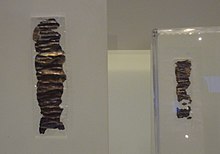| KH1 and KH2 scrolls | |
|---|---|
 The two scrolls on display | |
| Material | Silver |
| Writing | Paleo-Hebrew characters |
| Created | circa 650–587 BCE (pre-exile) [1] |
| Discovered | 1979 West Jerusalem, Jerusalem, Israel |
| Present location | Israel Museum |
The Ketef Hinnom scrolls, also described as Ketef Hinnom amulets, are the oldest surviving texts currently known from the Hebrew Bible, dated to c. 600 BCE.[2] The text, written in the Paleo-Hebrew script (not the Aramaic-derived Jewish square script Hebrew alphabet more familiar to most modern readers), is from the Book of Numbers in the Hebrew Bible, and has been described as "one of the most significant discoveries ever made" for biblical studies.[3][4]
The two silver scrolls were uncovered in 1979 at Ketef Hinnom, an archaeological site southwest of the Old City of Jerusalem, and were found to contain a variation of the Priestly Blessing, found in Numbers 6:24–26. The scrolls were dated paleographically to the late 7th or early 6th century BCE, placing them in the First Temple period.[5]
- ^ Barkay, G., A.G. Vaughn, M.J. Lundberg and B. Zuckerman, "The Amulets from Ketef Hinnom: A New Edition and Evaluation," Bulletin of the American Schools of Oriental Research 334 (2004): 41-71.
- ^ "Solving a Riddle Written in Silver". The New York Times. 28 September 2004. Retrieved 8 May 2010.
- ^ "The Challenges of Ketef Hinnom: Using Advanced Technologies to Recover the Earliest Biblical Texts and their Context", Gabriel Barkay et al., Near Eastern Archaeology, Vol. 66, No. 4 (December 2003), pp. 162–171 (at JSTOR) Archived 16 January 2017 at the Wayback Machine.
- ^ "Biblical Artifact Proven to Be Real". Webcenters.netscape.compuserve.com. Archived from the original on 10 November 2007. Retrieved 29 December 2011.
- ^ Barkay et al. 2003.
